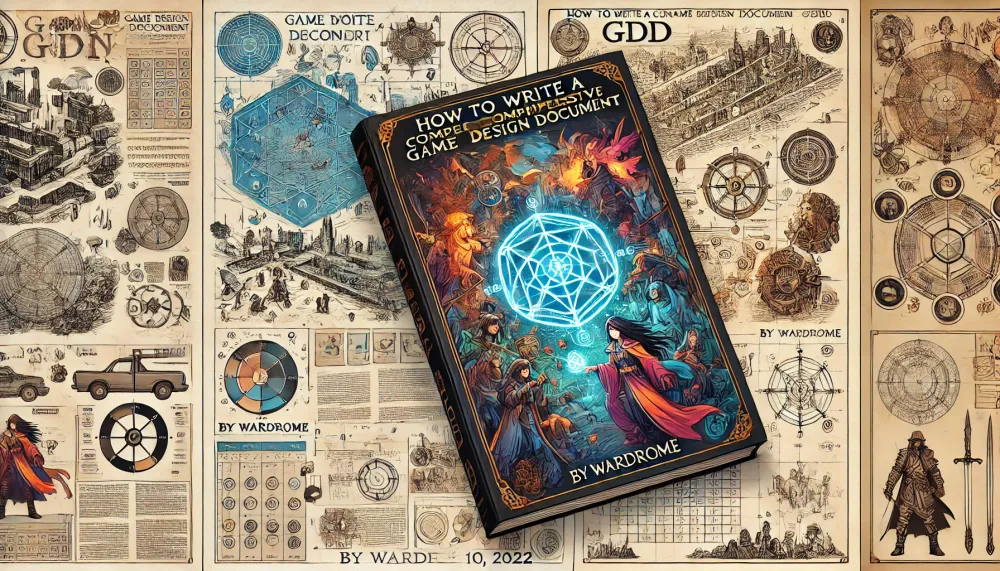How to write a Game Design Document
A Game Design Document (GDD) is a detailed blueprint for your game development project. It outlines the key elements of your game, including the game world, characters, gameplay mechanics, and storyline. A well-crafted GDD not only provides a roadmap for the development team but also ensures that everyone involved shares a clear vision of the game's goals and features. This article will guide you through the steps to create a thorough and effective GDD.
Steps to Writing a Comprehensive GDD
- Introduction
- Title Page: Start with a title page that includes the game's title, your name, and the date. This helps in organizing and referencing the document easily.
- Table of Contents: An organized list of the sections in the document. This allows team members to quickly navigate to specific parts of the GDD.
- Executive Summary: Provide a brief overview of the game concept, target audience, and unique selling points. This section should capture the essence of the game in a concise manner.
- Game Overview
- Game Concept: Outline the basic concept of your game, including the setting, characters, and overall goals. This section provides the foundation for the rest of the GDD.
- Genre: Specify the genre(s) of the game (e.g., action, adventure, RPG). This helps in setting the tone and expectations for gameplay.
- Platform: List the platforms on which the game will be released (e.g., PC, consoles, mobile). This information is crucial for technical planning and marketing strategies.
- Game World
- Setting and Aesthetic: Describe the game world in detail, including the overall setting and aesthetic. Highlight any unique features or locations that will be included in the game. Use visual references if possible.
- Lore and History: Provide background information on the game world, including its history, mythology, and major events. This adds depth to the game environment and enhances the storytelling.
- Characters
- Main Characters: Describe the main characters in your game, including their backgrounds, motivations, and personalities. Be sure to include any special abilities or skills that they may possess. Visual references or concept art can be very helpful here.
- Supporting Characters: Detail the supporting characters, including their roles in the story and their relationships with the main characters. This section helps in building a rich narrative.
- Enemies and NPCs: Outline the types of enemies and non-playable characters (NPCs) the player will encounter. Include information on their behavior, abilities, and how they contribute to the gameplay.
- Gameplay Mechanics
- Core Gameplay: Outline the core gameplay mechanics and features of your game. This should include information on how the game will be played, as well as any special abilities, items, or mechanics that will be included.
- Controls: Describe the control scheme for the game, including key mappings and interface interactions. This is vital for ensuring a smooth player experience.
- Progression and Rewards: Explain the progression system (e.g., leveling up, skill trees) and the reward systems (e.g., achievements, collectibles). This keeps players engaged and motivated.
- Storyline
- Main Plot: Describe the storyline of your game, including the main plot points and any key events or challenges that the player will face. A well-crafted story can greatly enhance player immersion.
- Branching Paths and Endings: Include information on how the game will end and any potential branching paths or alternate endings. This adds replay value and depth to the narrative.
- Cutscenes and Dialogue: Detail any major cutscenes and important dialogue sequences. Ensure these are well-written and contribute to the overall story.
- Art and Audio
- Visual Style: Describe the visual style and artistic direction of the game. Include references to art styles, color schemes, and graphical elements.
- Sound Design: Outline the sound design, including music, sound effects, and voice acting. High-quality audio can significantly enhance the gaming experience.
- Technical Specifications
- Engine and Tools: Specify the game engine and development tools that will be used. This section should also include any middleware or third-party tools.
- System Requirements: List the minimum and recommended system requirements for the game. This helps in setting realistic expectations for performance.
- Project Plan
- Development Timeline: Provide a timeline for the development of the game, including key milestones and deadlines. This helps in managing the project and keeping it on track.
- Team Roles and Responsibilities: Define the roles and responsibilities of each team member. Clear delineation of tasks ensures efficient workflow and accountability.
- Appendices
- References and Inspirations: Include any references, inspirations, or resources used in the development of the game. This can provide context and justification for design choices.
- Glossary: Provide a glossary of terms used in the GDD. This ensures that all team members understand the terminology.
Review and Revision
Once your GDD is complete, review it carefully and make any necessary revisions. A well-written GDD is an essential tool for any game development project and can help to ensure that your game is developed in a clear and consistent manner. Regular updates and revisions may be needed as the project evolves.




